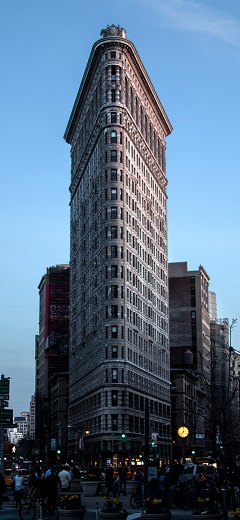
The Fountainhead, part 4, chapter 14
Before finishing with chapter 14, an aside: I’ve been reading The Flatiron by Alice Sparberg Alexiou, a book about New York’s iconic triangular tower.
When you read a historical account of New York in the early 20th century, it becomes clear that Rand didn’t exercise a great deal of creativity in writing The Fountainhead. She just took real people and events and slapped a coat of paint on them.

In particular, it’s true that American architecture was struggling with an identity crisis. In the 1900s, the nation was prosperous and New York was booming, but our cities were widely viewed as ugly, slapdash and soulless compared to the ornate palaces and ancient ruins of Europe. The question was whether to continue as we were, or to try creating high culture of our own (this was what motivated the Columbian Exposition that Rand saw as a sign of creeping collectivism).
The same goes for her characters. As I’ve mentioned, Howard Roark is based on Frank Lloyd Wright (although Wright hated the comparison, saying, “I deny the paternity and refuse to marry the mother”). Gail Wynand is based on yellow-journalism titan William Randolph Hearst. Roark’s mentor Henry Cameron was based on Louis Sullivan, who was a pioneer in skyscraper design (and who, like his fictional counterpart, was known for being surly, obstinate and difficult to work with, and died alcoholic and penniless because of it).
The only thing that Rand really contributed was the moral gloss she put on these events, deciding that some architects were good and others were evil based on their aesthetic choices. And the Flatiron Building, on the surface, would fit right into an Objectivist morality play. Critics hated its unconventional design, the public feared it would collapse, it had to overcome a corrupt union boss who demanded kickbacks and opposition from the city’s building inspectors; but ultimately, it ended up triumphing and becoming a much-loved landmark.
But at the same time, it was built in the classical style that Rand despised. The Flatiron’s designer, Daniel Burnham, made it reminiscent of a Greek column, with the facade divided into three sections corresponding to the base, shaft and capital. In The Fountainhead, this would have marked him firmly as a socialist amoeba, whatever his other views.
Before I move on from Ellsworth Toohey’s big villain monologue, I want to point out a contradiction that I don’t think Ayn Rand noticed. Here’s Toohey’s explanation for why he doesn’t want people to be happy:
“Happiness is self-contained and self-sufficient. Happy men have no time and no use for you. Happy men are free men. So kill their joy in living. Take away from them whatever is dear or important to them. Never let them have what they want. Make them feel that the mere fact of a personal desire is evil.”
But in the same speech, Toohey goes on to explain that there will be no self-sufficient creators like Howard Roark in his collectivist dystopia. There will only be stuporous drones, like the brainwashed masses in Huxley’s Brave New World:
“And if freaks persist in being born occasionally, they will not survive beyond their twelfth year. When their brain begins to function, it will feel the pressure and it will explode. The pressure gauged to a vacuum. Do you know the fate of deep-sea creatures brought out to sunlight? So much for future Roarks. The rest of you will smile and obey. Have you noticed that the imbecile always smiles? Man’s first frown is the first touch of God on his forehead. The touch of thought. But we’ll have neither God nor thought. Only voting by smiles. Automatic levers — all saying yes…”
Which is it? Are smiles and joy the rightful possession of thinking men? Or are they the domain of mindless morons, and thinking men scowl all the time? Is happiness the domain of the free and the fearless, or is it an anesthetic that keeps the untermenschen enslaved?
Although Rand paid lip service to the value of happiness, I think the second paragraph comes closer to what she believed. As Doug Langley noted in last week’s comments, her dominant mode was gloom and paranoia, and that bleeds through into her writing. Her protagonists scorn family, friendship, socializing and leisure, and believe that everyone should derive fulfillment from spending days and nights at the office.
Howard Roark is an emotionless cinderblock, for better or for worse – his own employees think of him as cold and inhuman – and one of the scenes where he seems happiest is mingled with harsh condemnation and disgust at other people who aren’t having the ideologically correct kind of fun. He’s sullen and nasty to people who are trying to do him favors. If he has a defining character moment, it’s the scene where he breaks into Dominique’s house and rapes her, and throughout that awful episode he displays no emotion but stony cruelty.
The same goes for Atlas Shrugged. There are a few sections that hint at genuine enjoyment, like Dagny’s train ride; but most of the time, her heroes and heroines are either icy cold and domineering, or exploding with rage at the incompetence they’re forced to do battle with. They hate nature, despise their families, and ooze with contempt for humanity, whom they describe as leeches, parasites, moochers and looters. For every scene where they enjoy a symphony, there’s another where they threaten to beat their wives, or shoot people in cold blood, or throw government bureaucrats down the stairs.
This seems inevitable, given Rand’s worldview as expressed in both books: heroic creators are vanishingly rare, frequently persecuted, and always scorned and reviled. The vast majority of humanity is an ignorant and vicious rabble that’s resentful of their betters and easily inflamed into a mob. This misanthropy reaches a climax in Atlas Shrugged, where it’s meant to be a happy ending when the heroes destroy civilization and ensure the deaths of tens of millions.
There’s no reason her books had to be this way. You can glorify human achievement without dismissing the mass of humanity as worthless scum. You can even praise capitalism without believing that anyone who goes hungry must have done something to deserve it. To do otherwise was a deliberate stylistic choice.
Howard Roark could have smiled, laughed, had friends and still have been a fearless and determined individualist. The heroes of Atlas Shrugged could have come back and rescued the world, earning the accolades of a grateful populace and the contrition of their former opponents who admitted they’d misjudged the capitalists. But that’s not the kind of story Ayn Rand wanted to tell. She was full of resentment at a world that didn’t value her as she believed she deserved, and she gave literary form to that conflict by writing revenge fantasies where the unworthy masses get what’s coming to them in the end.
Image of Flatiron Building via Ashland Thomas, released under CC BY-SA 4.0 license; header image credit: Kingnbm, released under CC BY-SA 3.0 license
Other posts in this series: